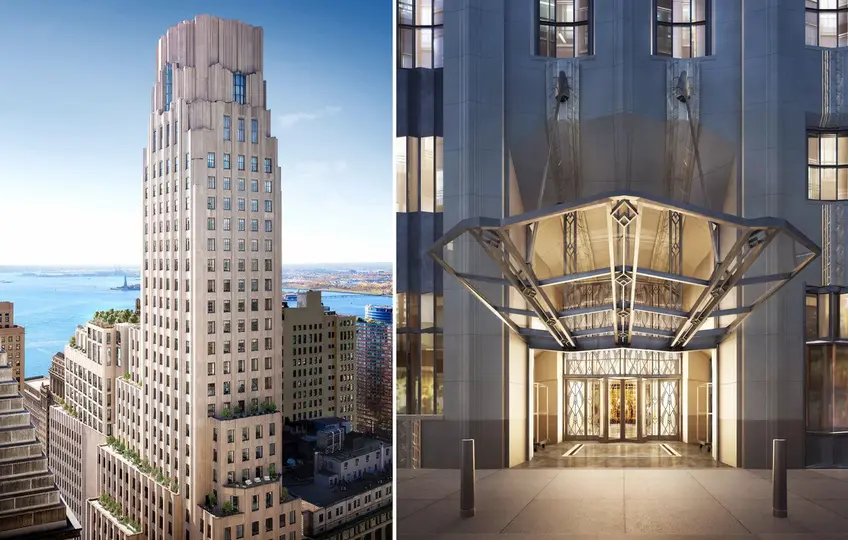 One Wall Street | Renderings created by DBOX for Macklowe Properties
One Wall Street | Renderings created by DBOX for Macklowe Properties
In recent years, office-to-condo conversions have become a staple of New York’s real estate market, particularly in lower Manhattan, where landmarked and preservation-worthy buildings abound; some conversions, however, stand well above the crowd. Among such elites is One Wall Street, a 566-unit conversion of the former Irving Trust Company Building at the junction of Wall Street and Broadway, arguably Downtown’s focal point. Led by Macklowe Properties with Robert A.M. Stern Architects/SLCE in charge of the design, the venture is among the largest recent sale offerings to the Financial District.
The 50-story, 1.1 million-square-foot project is reportedly the largest condo conversion in the city’s history. The 1931 designated landmark was designed by Ralph Walker, “Architect of the Century” as per the American Institute of Architects. Walker crafted a rippling facade and cavernous interiors in a bold Art Deco style.
Sales have launched on the apartments inside, and occupancy is expected for spring 2022. While we wait, we delve into the building's illustrious history, architecture, residences, and amenities.
Sales have launched on the apartments inside, and occupancy is expected for spring 2022. While we wait, we delve into the building's illustrious history, architecture, residences, and amenities.
In this article:
History
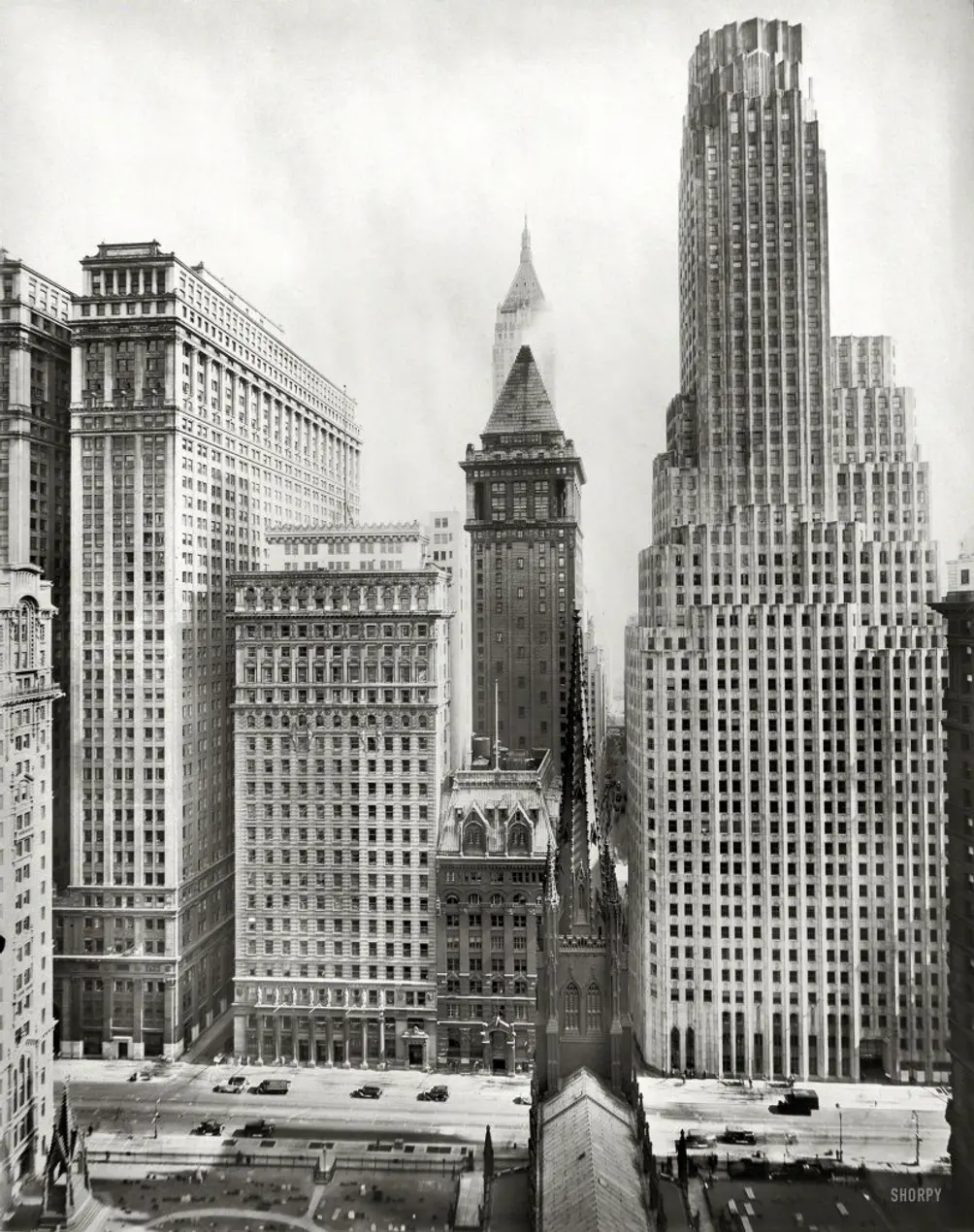 Irving Trust Building at 1 Wall Street circa 1931 | Photo credit: Irving Underhill via Shorpy
Irving Trust Building at 1 Wall Street circa 1931 | Photo credit: Irving Underhill via Shorpy
By 1925, New York had surpassed London as the world’s largest metropolis, and the Roaring Twenties bulled forward in pursuit of ever-lucrative gains. By this time, Wall Street has long since become the nation’s (and arguably the world’s) prime financial hub, with sky-high real estate tags matched by ever-growing skyscrapers, now synonymous with global success and prestige.
In 1905, a tiny, 30-by-40-foot lot at the coveted corner of Wall Street and Broadway, across from the brooding spire of Trinity Church, was sold for a record-setting price of $615 per square foot (around $17,000 per square foot in current value). The 18-story 1 Wall Street, finished two years later, was nicknamed the Chimney Building for its slenderness, reminiscent in land-value-driven proportions to modern-day 432 Park Avenue (coincidentally, another Macklowe property). But even this prime office property was deemed obsolete just twenty years later, when it was acquired as part of a larger site by the Irving Trust Company in 1927 and demolished shortly thereafter to make way for a lofty, lavish headquarters unlike any other.
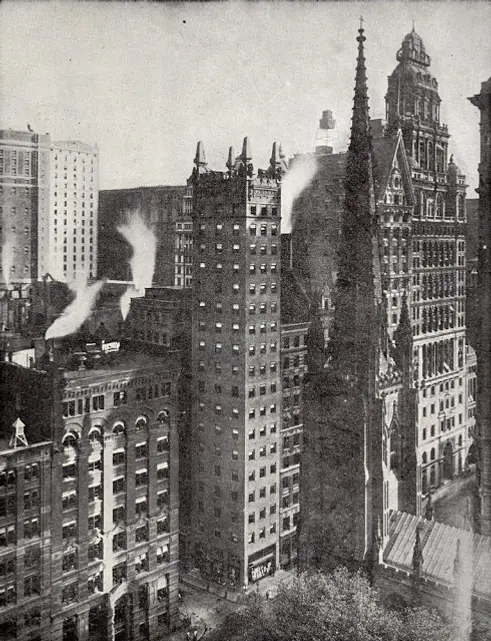 The pre-existing site of the Irving Trust Company Building at 1 Wall Street with the "Chimney Building" at the corner
The pre-existing site of the Irving Trust Company Building at 1 Wall Street with the "Chimney Building" at the corner
The nation’s fifth-largest financial institution would spare no expense on the crown of their banking empire. The board commissioned the firm of Voorhees, Gmelin & Walker, whose “starchitect” principal Ralph Thomas Walker’s recent rise to fame was propelled by a series of avant-garde commissions. The New York Telephone Building at 140 West Street (now with its condos known as One Hundred Barclay Tribeca) is often cited as the first major Art Deco edifice in New York. Walker's other buildings, many of which were also telephone facilities, mixed historical styles with novel Art Deco flourishes such as walls of undulating brick. One such structure, a former telephone switching station on West 17th Street, was renamed Walker Tower upon its 2012 vertical expansion and condo conversion.
At the time, a skyscraper fever gripped New York, with tower tycoons of Downtown competing against those in Midtown; all the while, both neighborhoods held sky-bound races of their own. In Downtown, the Irving Trust Building at One Wall Street raced against the 741-foot Farmers Trust Building at 20 Exchange Place, much of which was converted to rentals a few years ago; the 927-foot Bank of Manhattan Building at 40 Wall Street, which briefly reigned as the world’s tallest building before the Chrysler Building snatched the title; and the 952-foot Cities Services Building at 70 Pine Street, the tallest and latest of the bunch, completed in 1932 and converted to rentals in 2016. For more on the four-way skyscraper race, read Daniel Abramson’s and Carol Willis’ 2001 book Skyscraper Rivals.
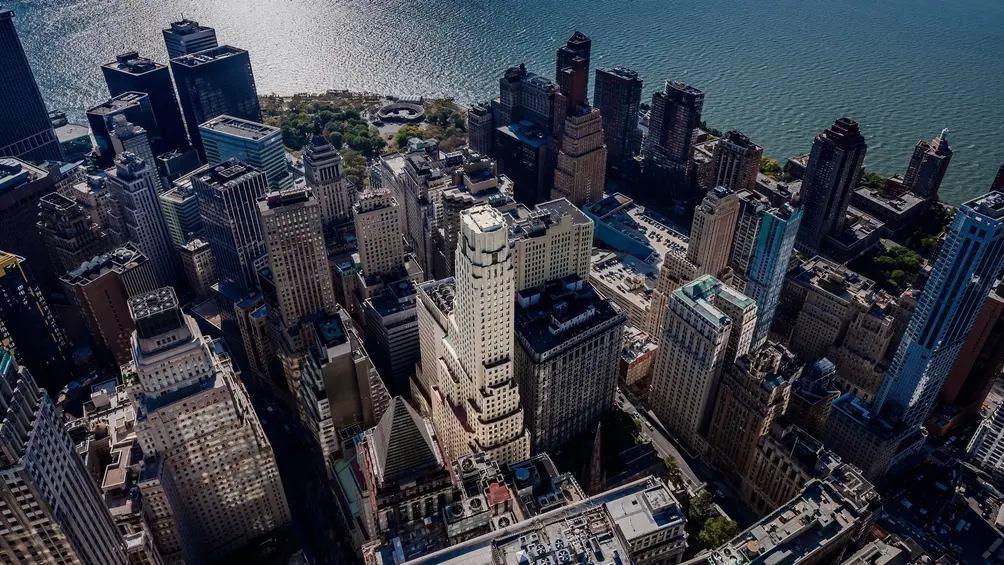 Photo: Credit: DBOX for Macklowe Properties
Photo: Credit: DBOX for Macklowe Properties
Architecture
At 654 feet and 49 stories, One Wall Street is the shortest among the four aforementioned giants in the Financial District, yet the seemingly-restrained building is arguably the most original and opulent of the group. Like its counterparts, the building’s basic form was driven by the zoning code, with a girthy base that telescoped in gentle setbacks into a slender tower. The rest of the building’s finesse came from Ralph Walker’s inventive genius.
Limestone has long been a popular material for skyscraper curtain walls, yet Walker took the concept in an almost literal direction with fluted, concave bays that at once soared skyward with confident Art Deco elan and rippled gently and curtain-like in the harbor breeze. The rippling metal facade of New York by Gehry, built in 2011, may be more visually striking, yet even this modern marvel lacks the subtle finesse of the pre-war masterpiece.
One Wall Street’s crown rises to a subtle yet dramatic pinnacle, flat at the summit yet ribbed with undulating chevron surfaces on all sides. In plan, the form bears resemblance to a floral ornament filtered through an Art Deco lens.
Similarly, instead of packing the lobby with gargoyles and lacy trim, Walker opted for an a wholly radical approach to evoke a spirit of refined luxury. At the ground level, dozens-feet-high windows, at once unmistakably Art Deco, somewhat Gothic, and even vaguely deconstructivist, seem chiseled through the stone facade, allowing pedestrians to glimpse the inside of the Red Room. The cavernous banking hall soars like the hearth of an enormous fireplace, with a oxblood, orange, and gold mosaic gradient, designed by muralist Hildreth Meiere, climbs toward and across the ceiling’s angled vaults.
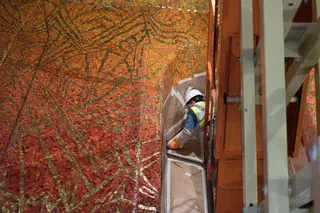 The incredible and meticulous renovation of One Wall's flamboyant Red Room | Credit: DBOX for Macklowe Properties
The incredible and meticulous renovation of One Wall's flamboyant Red Room | Credit: DBOX for Macklowe Properties
The White Room at the beacon-like skyscraper pinnacle matches the Red Room’s opulence with a flair at once familiar and entirely distinct. The onetime boardroom’s soaring ceilings are similarly notched and angled with cavelike geometries that substitute flamboyant mosaic with mother of pearl Phillipine shells that glimmer in the sunlight that pours through enormous, gently-pointed windows that overlook the skyline and the harbor.
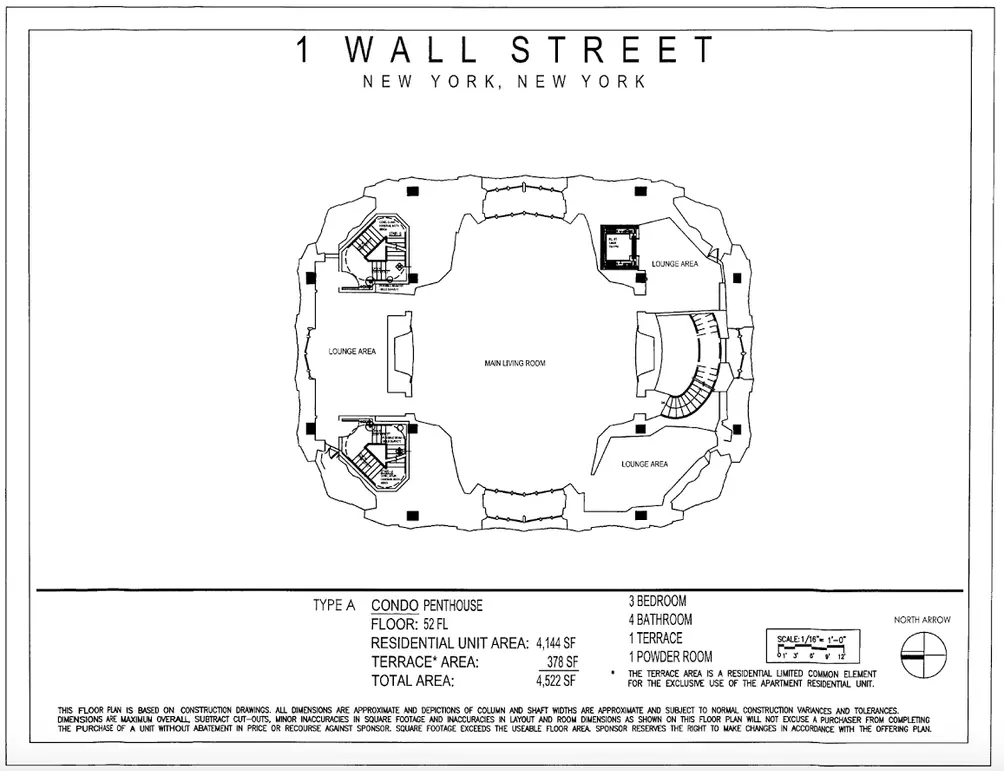 The White Room will become part of a 13,000-square-foot penthouse
The White Room will become part of a 13,000-square-foot penthouse
As the skyline rose to a glorious crescendo, the business district’s fortunes already spiraled in precipitous decline. The Irving Trust Building opened in 1931, two years into the ravages of the Great Depression that brought skyscraper growth to a grinding halt. The Financial District’s recovery would come only three decades later in the 1960’s, when corporate clients traded the prestige of height for the practicality of larger and wider floorplates, enabled by the advent of improved lighting and air conditioning. In 1963, One Wall Street gained a south annex that roughly doubled the area of the lower 28 stories and even emulated Walker’s rippling curtain wall, a rare and welcome contextual gesture for the go-go-modern sixties, albeit one that lacked the original’s finesse.
The Residential Conversion
In 1931, One Wall Street reigned as the tenth-tallest skyscraper in the world. Today, the tower ranks just as the 82nd-tallest in New York City alone, yet Ralph Walker’s zig-zagging chevron crown endures on an ever-growing, 21st-century skyline. Aging office buildings have a hard time meeting exacting demands of tech-savvy tenants, yet their charms also make them increasingly lucrative as residential conversions.
Macklowe Properties bought the lucrative, well-sited building in 2014. The six-year, 1.5 billion project involves a complete interior overhaul of the former office building, meticulous restoration of landmarked interiors, and the addition of a five-story vertical extension atop the non-landmarked, post-war south annex. SLCE Architects is listed as the architect of record.
Like its contemporaries, One Wall Street benefits from its era’s characteristic qualities. Small upper-level floorplates, ill-suited for large corporate tenants, make for exclusive, sun-filled residences that look out upon the skyline, out onto the harbor, and far beyond. Zoning code-mandated setbacks make for lofty terraces. Opulent architecture and indulgent interiors offer luxe eye candy that few, if any, modern buildings can match. The location at the corner of Wall Street and Broadway, once crucial for a major bank, now sits within of a round-the-clock, restaurant-rich, mixed-use neighborhood sited at the center of a greater-than-ever metropolis readily accessible by ample local subways.
The Residences
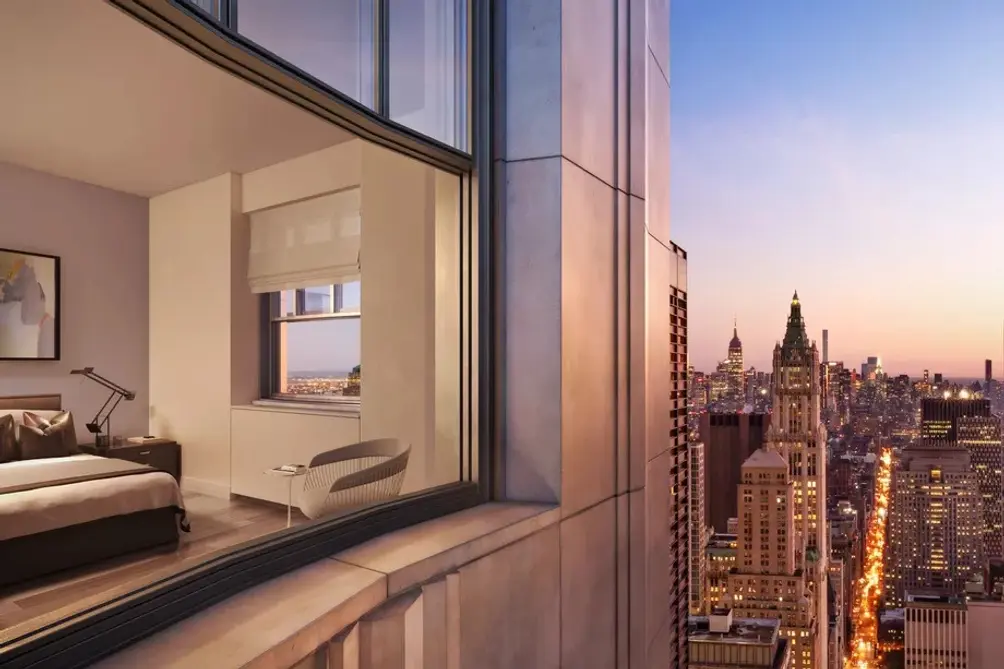 Rendering credit: DBOX for Macklowe Properties
Rendering credit: DBOX for Macklowe Properties
Between the building’s original form, the post-war annex, and the extension on top of the annex, One Wall Street allows for an array of interesting apartment layouts ranging from studios to four-bedrooms. Current availabilities start at $990K for studios, $1.385 million for one-bedrooms, $1.995 million for two-bedrooms, $3.815 million for three-bedrooms, and $12.75 million for four-bedrooms. The penthouse is not yet listed, but will include the building’s beautifully restored White Room.


All units boast ceilings over 10 feet high, wide-plank French oak hardwood floors, and features that pay tribute to 1930s character. Lower floor homes enjoy extraordinary views of Trinity Church and the New York Stock Exchange, and upper-level residences look out on jaw-dropping vistas of the Manhattan skyline and New York Harbor.
Chef-styled kitchens will come outfitted with marble countertops and backsplash, brilliant white Aran Cucina custom cabinetry, Miele appliances, externally venting exhaust fans, and InSinkerator garbage disposals. Additional features include stone and marble baths in all units, as well as home offices and/or outdoor space in select units.
Chef-styled kitchens will come outfitted with marble countertops and backsplash, brilliant white Aran Cucina custom cabinetry, Miele appliances, externally venting exhaust fans, and InSinkerator garbage disposals. Additional features include stone and marble baths in all units, as well as home offices and/or outdoor space in select units.
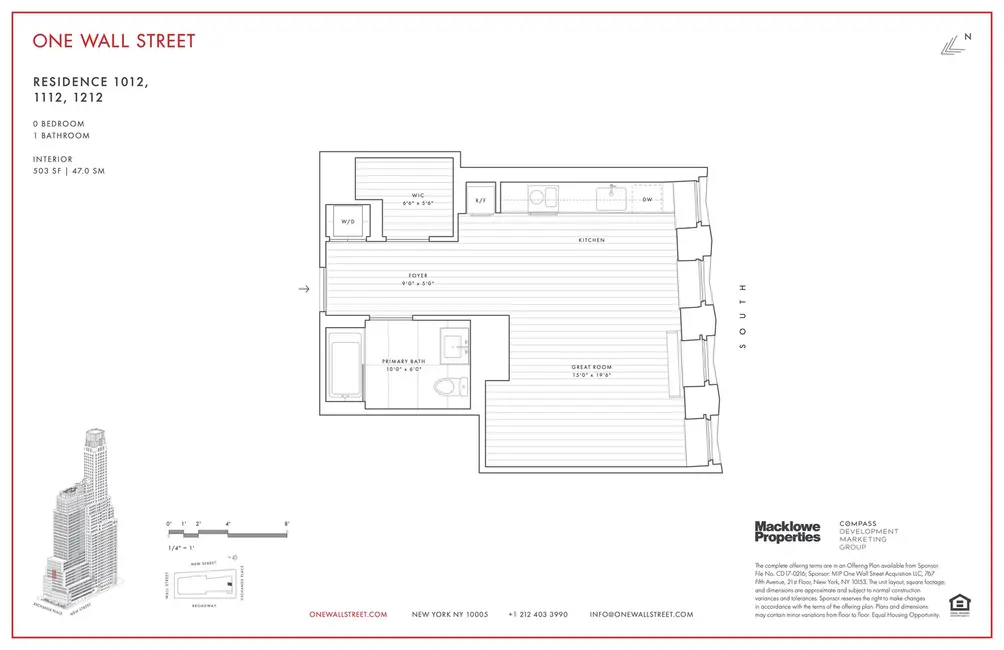
At One Wall Street, even the smallest studios enjoy walk-in closets and in-unit washer/dryers. The southern exposure of #1112 will fill every inch of the space with abundant natural light.

Upon arriving at #731, a gracious foyer with a large closet leads to the open kitchen and living area. The bedroom enjoys the same views of Wall Street as the living room, not to mention generous closet space.

Oversized, east-facing windows fill the bedrooms and Great Room with abundant light. The kitchen is finished with Lincoln Calacatta marble from the same quarry as the Lincoln Memorial.

Apartment #3003 features a compact layout and sizable rooms. The bedrooms are well separated from the living area and kitchen.

On the corner of the building, #2308 enjoys a grand foyer and Great Room with double exposures. The primary bedroom, and a secondary bedroom face west over Broadway, while the third bedroom faces south.

In #2414, the Great Room and all three bedrooms open up to a 467-square-foot private terrace. The foyer is spacious enough to double as a home office.

#1901 is wrapped around the northwest corner of the building. Interiors feature a full laundry room and powder room off the foyer.

In this massive unit, the Great Room, formal dining room, primary suite, AND secondary bedroom suites open up to a 1,314-square-foot private terrace facing New York Harbor. A north-facing room off the Great Room may be used as a fourth bedroom, library, home office, or anything else the buyer desires.
The Amenities

The One Club encompasses 100,000 square feet of residential amenities and spans several floors. In addition to a complimentary membership to Life Time Fitness, residents will enjoy access to a 38th-floor private gym with a 75-foot lap pool overlooking Lower Manhattan and New York Harbor. The 39th floor will house a restaurant exclusive to residents and their guests, and be flanked by a 4,000-square-foot landscaped terrace.
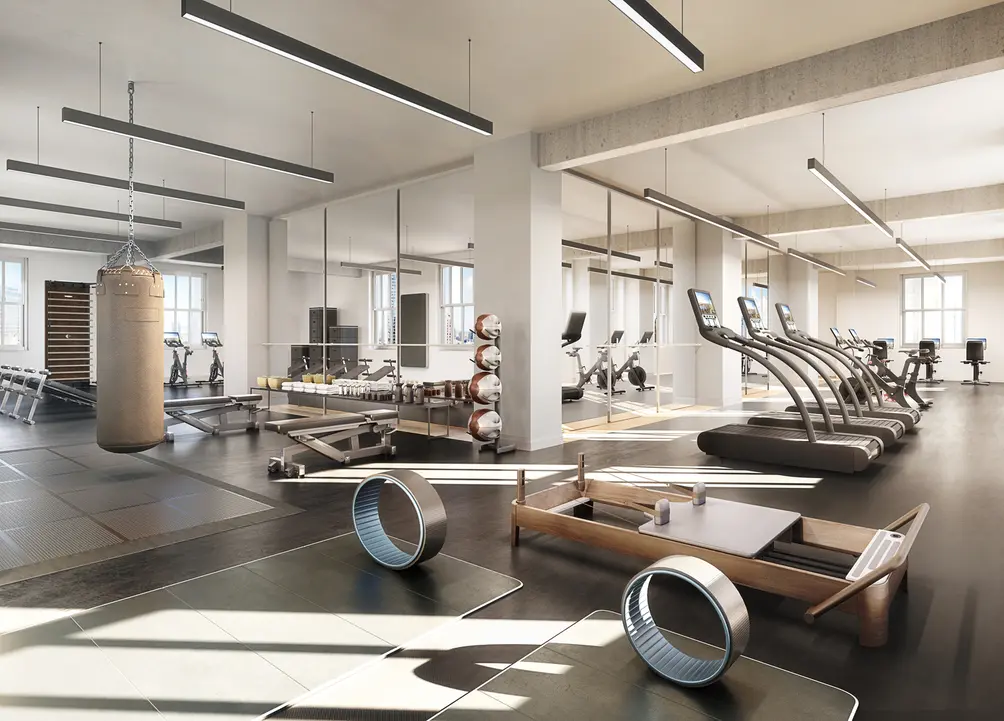

Additional amenity offerings will include a children’s playroom, teen lounge, and private co-working space with conference rooms. Private storage and a bike room will also be available for residents’ convenience. Moreover, the building will be staffed by full-time doormen and porters, full-time resident managers, and white-glove concierge service.

One Wall Street will liven up Broadway with 106,000 square feet of retail spread across three levels, with a 44,000-square-foot Whole Foods providing a much-needed major supermarket for the neighborhood. The lower levels of the post-war annex, not protected by Landmarks ordinances, are shedding the somber stone cladding in favor of transparent, pedestrian-friendly glass frontage.
Glass prudently recedes on the annex’s northern side, which abuts Ralph Walker’s landmarked tower. There, the tall-ceiled Red Room readies to accept a retailer, though the tenant remains unknown. To some, the landmarked banking hall’s transformation into a shopping emporium may seem irreverent, yet the move will democratize the astonishing interior, providing access for the average person for the first time.
While the White Room at the pinnacle is similarly preserved and restored, it will sadly lack public access like its red counterpart, much as we would have loved to see the shell-clad space become a public observatory. The singular space will go to the lucky owner of the penthouse.
Would you like to tour any of these properties?


 6sqft delivers the latest on real estate, architecture, and design, straight from New York City.
6sqft delivers the latest on real estate, architecture, and design, straight from New York City.
